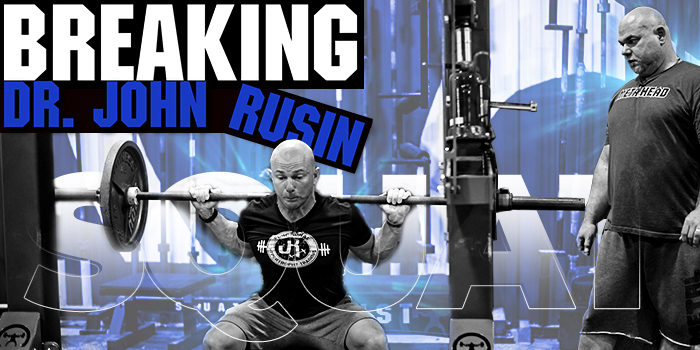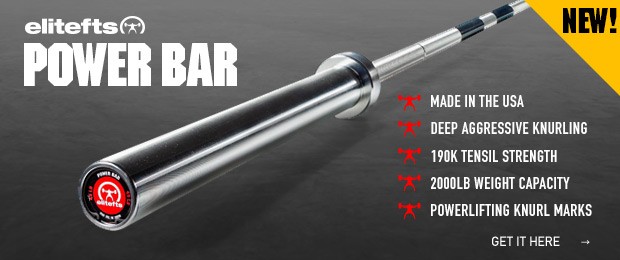
As part of the Fixing Dave Tate Series that kicked off earlier this year, Dave Tate worked closely with Dr. John Rusin to conduct a physical evaluation and develop a training program to reduce his daily pain. Having progressed through this journey over the past several months, Tate has since recognized the benefits and insights that he gained in the process. Yet, he is not alone – Dr. Rusin also acknowledges the headway that was made during the series.
In fact, while conducting the Fixing Dave Tate project, Rusin began to consider how this kind of process could be applied to his own training. Although he is no longer a competitive athlete, he still wants to be a role model for his clients by growing stronger and building the “big three” lifts: squat, bench press, and deadlift. As Rusin emphasizes with his own clients, health should always be the number one priority, but performance is a close second – and he sees the big three lifts as key indicators of overall performance.
As astutely stated by Rusin, “Every great coach needs a coach – they need somebody else to look in from a different, niche part of the industry”. Not only is this true, but when it comes to optimizing movement patterns to build the big three lifts, there is perhaps no coach more qualified than Dave Tate. In working together, they have the ability to flip the script and develop a 6-12-month program to accelerate Rusin’s progress on these main accessory lifts.
In alignment with this plan, Rusin recently joined Tate for an individual coaching session to break down his squat technique in an effort to improve his form. As Tate observed Rusin, he provided targeted cues and hands-on instruction to correct the bad, elevate the good, and enhance overall performance. From proper squat set-up and stance, to optimal breathing, bracing, and body placement, Tate dispelled commonly-accepted myths about squatting and provided expert tips for excelling at this high-tension movement.
Setting Up for Breaking Down
As part of the “breaking” process, Tate first has Rusin warm up like he normally does before a lifting session. This helps him to be loose and ready before any changes are made to his form. As Tate explains, he typically doesn’t even like to watch athletes warm up before these kinds of sessions in order to approach breaking with fresh eyes.
While preparing to squat, it becomes clear that there are some differences between Rusin’s normal weight room set-up and the layout of the elitefts gym. As Rusin explains, he typically squats in front of a mirror, meaning that his vision is at his feet. Although seemingly insignificant, the presence of mirrors during lifting sessions affects Rusin’s usual squatting head placement: neutral and slightly extended, watching his feet.
To simulate a mirror, Tate moves a collar for Rusin to look at – first four feet off the ground, then two feet off the ground, then finally adjusting to place it on the floor. With this tweak, Rusin’s form changes to reflect his typical, neutral head position. Once Tate is satisfied that they have established a solid baseline that represents Rusin’s usual squatting behavior, he is now prepared to begin the breaking process.
“[Whether] I agree or disagree with his head position is kind of irrelevant, because I need to know what he squats every single day… His steps changed tremendously on his walk-out just with that one thing. So now I can start looking to see if there’s anything to fix because you don’t want to fix anything that’s not even real, to begin with.”
Rooting the Feet
Tate starts his corrective coaching at the bottom, with Rusin’s feet. Because Rusin does a fair amount of single-leg work in his training, he actually tends to take the bar out with one leg, rather than squaring his feet. Yet, athletes will be stronger with both feet symmetrical, their toes rooted into the floor. Tate explains that having the feet firmly planted becomes even more critical when a box is added to squatting movement.
“I don’t care how you think about rooting your feet, if it’s turning, twisting, grabbing –whatever it is – but you’ve got to root a little bit better, especially when you are box squatting…because as soon as your weight goes on the box, your toes are coming off the floor. So, you’ve got to grab even harder when you’re on the box.”
To help address this tendency to lift the toes, Tate advises Rusin to act as though he is doing a leg curl when he’s sitting on the box. This mentality pushes him to squarely drive his feet back into the floor and bring his hips forward.
Having corrected the feet, Tate next looks to Rusin’s stance. He finds that his knee position and hips are “more right than wrong”, despite the fact that his stance is not as wide as others may assume that it needs to be. He explains that they could train to move his stance out in an attempt to shorten the bar path, but the results would not be that significant given the way that Rusin is built. It’s not worth putting his groin at risk to do so, especially when Rusin has the mechanics that are working for him in his current stance. Contrary to popular belief, a wider stance is not always better, and as such Tate emphasizes that he never makes those types of calls until he actually sees somebody squatting.
Rusin nods in agreement, explaining that he has a very specific stance given the way that his hips and pelvis are positioned. If he widens too much, he risks pain in his back or adductors, and thus only adjusts his stance for very specific training movements:
“As soon as I go out even half of an inch in my stance, it totally changes the game – I’m devastatingly sore at the adductors. The only time I use that is if we are going to go through a trap bar deadlift cycle, knowing very much so that we have more anterior chain dominancy there. I will move out the squat just the tiniest of bits…but that’s the only time I alter it.”
Tate also addresses Rusin’s stance on the way back up from his squats. He explains that the last part of the body to move going down into the squat is the chest, and so it should be the first thing to move when coming up from the box. To execute this, Tate cues Rusin to keep his chest and sternum up during the movement. This enables more of a pelvic tilt, while still protecting the back with a neutral position. Tate notes that especially if an athlete is explosive, this is really the source of their power in finishing out the squat.
Breathing and Bracing
Next, Tate and Rusin move on to discuss an important but often underestimated aspect of powerlifting: breathing technique. Rusin explains that he holds his breath during the squatting movement, breathing in deeply through his mouth before he un-racks. Tate offers that it might actually be more helpful for Rusin to breathe through his nose while he’s under the bar, pushing his diaphragm down and filling his body with air. Although athletes shouldn’t hold their breath too long, breathing first through the nose before un-racking enables them to take a small, quick breath through the mouth before the squat movement itself.
Tate goes through a series of breathing exercises with Rusin until he is able to feel (and see) the difference in his squats. The pressure of the breath, when done correctly, is felt more in the belly or the core of the body, as opposed to in the neck and chest. Tate adds that this extra breath through the mouth is one of the benefits of using the mono when squatting.
“You can step back and then take a little bit more in through the mouth. Even if it’s just a couple cubic centimeters more, that’s a little bit more brace that’s going to make a world of a difference.”
Adding the Belt
Tate continues his focus on breath, but first has Rusin to put on his belt for added pressure. They practice stomach breathing – in through the nose, then through the mouth – and discuss that the pressure should be felt throughout the whole belt. Then Tate adds some additional weight to the bar and Rusin begins to squat.
When squatting with the belt on, Rusin acknowledges that he is actually falling back slightly during the movement, which is a new phenomenon for him. Nodding, Tate explains that this will be eliminated by adding more weight on the bar. Furthermore, he notes that he actually wants the body weight to be falling backwards, which is why he initially added the extra weight to the bar. He encourages Rusin to breathe and continue to grip with his toes, ensuring that his core is stabilized and braced. In doing so, Rusin performs some of his best reps yet, proving that Tate’s analogy for a strong and stabilized midsection is well-warranted:
“If you were to squat and I was to remove the midsection and put a marshmallow in there, how much force would transfer to the bar from the floor? None. Now, if I took that [midsection out] and put a rock in there, how much force is going to transfer? Everything.”
Time Under Tension
As they wrap up the session, Tate notes that Rusin should feel more exhausted from the squat in comparison to before, after tightening his body and bracing harder. Ultimately, this is because the time under tension for a squat is greater than any other movement. Many people misguidedly measure tension from the time the bar is removed, to the time it’s placed back on the rack. However, as Tate clarifies, as soon as an athlete takes hold of the bar and begins to breathe and tighten underneath it, the time under tension has already begun.
Because squatting is a high-tension movement lasting longer than any other powerlifting exercise, the “breaking” process is critical for success. By isolating and correcting the micro-movements of each body part involved in a squat, athletes can improve their overall form and optimize performance.









